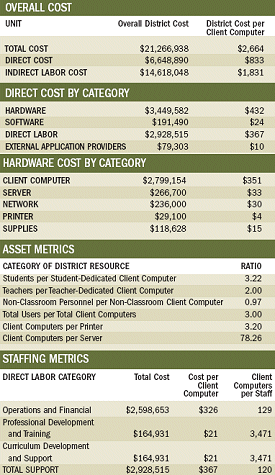Special Section: Resource Management :: Value Judgments
##AUTHORSPLIT##<--->
ARE YOUR TECHNOLOGY EXPENDITURES PROVING TO BE MONEYWELL SPENT? A NEW ONLINE TCO TOOL WILL LET YOU KNOW.
 CONGRATULATIONS! You’ve just been hired as the superintendent of Unnamed Unified School District No. 4! Everyone’s looking to you as a leader, an innovator, someone who can bring the district’s students and staff the technologies of the 21st century with a minimum of fuss and money. Be modern, but be smart, say the members of the school board, eyeing their budget. Get our children what they need, but don’t go crazy, say the parents, anticipating a tax hike. Make it fun, but make it easy, say the teachers, fearing humiliation in front of their tech-savvy students. Look at these colorful brochures, say the vendors, knocking on your office door. Suddenly, this job doesn’t quite look like theplum it did before.
CONGRATULATIONS! You’ve just been hired as the superintendent of Unnamed Unified School District No. 4! Everyone’s looking to you as a leader, an innovator, someone who can bring the district’s students and staff the technologies of the 21st century with a minimum of fuss and money. Be modern, but be smart, say the members of the school board, eyeing their budget. Get our children what they need, but don’t go crazy, say the parents, anticipating a tax hike. Make it fun, but make it easy, say the teachers, fearing humiliation in front of their tech-savvy students. Look at these colorful brochures, say the vendors, knocking on your office door. Suddenly, this job doesn’t quite look like theplum it did before.
Rich Kaestner feels your pain.
Kaestner is the TCO (total cost of ownership) project director for the Consortium for School Networking, a national nonprofit group that helps K-12 schools effectively use technology to improve both teaching and learning.
CoSN, in tandem with Gartner, a research and advisory firm, has developed a free, vendorneutral, online tool—in the words of its website, “to help schools and school districts make sound budgetary decisions, conduct technology planning in an organized way, establish a baseline for future analysis, and maximize benefits from their investments in technology.” The tool is available here; so far, 1,700 school districts have signed up to use it.
How does it work? First, district (or school) technology staff read background about the tool online. Then they gather information that will form the basis for their analysis. The tool includes the following components:
- a web-based interactive survey instrument
- a set of definitions to guide districts in their data collection
- a discussion of methodology, suggesting best practices for undertaking a TCO assessment
- an introductory section, discussing the benefits of monitoring TCO
- case studies that describe how school districts of varying sizes used the TCO tool’s metrics to assess their own technology implementations
Next, the district feeds its information into the tool, which calculates metrics that can be measured against the high and low numbers computed for the case-study districts. A report is generated, revealing how much of your money is going where, and how that compares to other districts.
A CoSN report on “Why Total Cost of Ownership Matters” suggests that school districts conduct regular TCO analyses that accomplish the following:
- provide management oversight
- identify and document both direct and indirect costs
- measure and improve the effectiveness of technology initiatives
- develop and document budgetary guidelines
- develop the business case for new technology projects
- inform stakeholders of management practices and budgetary needs
Given that the TCO tool is free and available, given that all districts need to produce accurate budgets, and given that with planning, districts can save money and provide better services, one has to wonder why anyone wouldn’t use the tool, especially when districts are implementing such individualized programs.
THE VALUE OF VOI
A companion to TCO can provide more helpto schools in evaluating the cost-effectivenessof technology initiatives.
The Consortium for School Networking (CoSN) has developed a companion to its total cost of ownership tool: value of investment (VOI). The project is formally named the Value of Investment Leadership Initiative, and its intent is to help schools better evaluate the costs and benefits of proposed technology programs. Among the initiative’s sponsors are Intel, Gateway, and SchoolNet. Whereas TCO looks at installed (and optionally planned) computer environment costs, VOI looks at expected costs and benefits of technology projects. CoSN’s VOI website outlines a five-step approach for determining value of investment:
- Estimate project costs.
- Assess risk.
- Calculate anticipated savings and revenue.
- Measure qualitative benefits.
- Evaluate results.
The site provides tools such as the Project Cost Estimator and the Project Benefits Worksheet.
The analysis the tool provides is essential, says Kaestner, if you’re trying to decide which kinds of technology—hardware, software, training, and support—to acquire. Why? Kaestner is reminded of the Cheshire Cat’s moderately helpful advice in Alice in Wonderland. Alice asks, “Would you tell me, please, which way I ought to go from here?” And the Cheshire Cat responds, “That depends a good deal on where you want to get to.” More to the point, says Kaestner, “If you don’t know what your technology’s costing you, how do you know what to do?” The TCO tool helps you figure that out.
TCO Points the Way
Case in point: Kershaw County School District in Camden, SC, which numbers 10,200 students, 733 teachers, and 418 staff. Currently, all of Kershaw’s 20 schools are wireless, with 3,300 laptops in grades 9-12. But it wasn’t always so—far from it.

Supt. Herb Berg has raised ed tech
spending in Kershaw County SD from
$4 per student to $200 per student.
The online TCO tool helps direct the
money to where it’s needed.
Herb Berg is Kershaw County’s superintendent for public instruction. A superintendent for 30 years, he came to Kershaw County in 2002, bringing with him the knowledge that “really good districts have a technology component.” South Carolina state guidelines indicated that the average expenditure of educational technology was about $225 to $250 per student.
Kershaw County was spending about $4 per student.
Berg was confronted with two tasks: first, to get his district up to normalcy; and second, to determine just what kinds of technology the district was actually spending money on. To accomplish the first task, he and his business team managed to borrow $2 million for four years—a big step—which brought the spending ratio up to $200 per student. Then he sent out a request for proposals to vendors. As Berg says, “We wanted the billiondollar companies to tell us what we could do for that money.”
Hewlett-Packard won the competition, mainly because of its emphasis on training teachers. According to Berg, another company actually came in a lot cheaper on the hardware, but “they’d drop the box off at the door, and that was that.” Whatever was implemented, thought Berg, he wanted teachers involved from the outset.
Next, HP and Kershaw County went to work on determining just where the money ought to go. It turned out that a 1-to-1 program— one laptop to one student—was the choice. Fully 25 percent of the first year’s investment went to training; that secured buy-in from teachers. “Training helped the teachers immensely,” says Berg. “There was no resistance or pushback. Just the opposite. They were anxious for more.” John Stiver, the district’s executive director for secondary education, says, “Laptops are just a box if we don’t train the teachers how to use the software to integrate the technology into the curriculum.”
While the training was under way, the second task could be addressed: There needed to be some accounting of how the current technology budget was being used. That’s where the online TCO tool came in. The process was simple but not easy—just ask Phyllis David, Kershaw County’s director for operational technology. She worked with Kaestner on getting the information to be analyzed. She made a total inventory of the computers on each site, along with the costs of maintaining all the technology, such as it was. The initial survey required a signifi- cant chunk of time—four to six weeks—especially the digging for information from old files and from various grants and programs. But when David and Kaestner finally came up with the information, it proved invaluable. David was thrilled with the results. The TCO report acknowledged what she knew all along—in her words, “Folks, you’ve got aging computers.” Thereport also supported the need for more staff, and strongly supported standardization. Each site in the district had been usingdifferent hardware and software—a nightmare for district staff,who had to install, program, monitor, and repair the computersand otherwise support teachers. Now all technology purchasesare reviewed quarterly by a districtwide committee and approvedby David. Although the information was difficult to ferret out thefirst time, David thinks it’s great that the district is drawing up atechnology budget each year. The information buttressed the HPinitiative and cleared the way for future projects.
TOOLIN’AROUND
The following sample report generated by the Consortium forSchool Networking’s total cost of ownershiptool provided one district’s leaders with the data to make theappropriate educational decisions. First, some definitions:
- TOTAL COST: a balanced look at how much it truly takes to support a computer
- DIRECT COST: all technology and direct labor costs—hardware, software, external application providers, direct labor
- INDIRECT LABOR COST: the costs of users supporting one another and themselves, attending training classes, learning informally, developing user applications, and experiencing downtime
- HARDWARE: computers, peripherals, servers, network equipment, printers
- SOFTWARE: infrastructure software, educational administrative software, personal productivity software, contentand curriculum-specific software
- DIRECT LABOR: includes burdened salaries from personnel whose jobs include operations and financial support, professional training and development, or curriculum development
- EXTERNAL APPLICATION PROVIDERS: organizations that provide the use of applications and associated services

In the case of this district, the report provided some importantobservations about expenditures compared to those ofother case-study districts:
- Overall hardware costs were high.
- Direct labor costs were at the norm.
- Printer costs were low.
- Supply costs were high.
- Network costs were high.
With this analysis, district managers could clearly see where too much or too little of their money was going, and where it might be shifted to be brought more in line with the budgets of successful districts.
The results for Kershaw have been uniformly positive. The number of hours that its students use technology has dramatically increased. Attendance and engagement in school have shot up as well. Teachers say students are doing better in language arts. Stiver says the district has since restructured its middle school curriculum to prepare students for technology— they’ll be receiving less instruction on keyboarding and more on programs such as Word, PowerPoint, and Excel.
At this point, every K-12 student in the district is slated to receive some kind of technology training. When the initial cohort of students with laptops graduates, those kids will be among the most technologically adept in the state. The business community, says Berg, is taking notice.
The TCO reporting ensured that the 1-to-1 program isn’t going to be a one-shot effort. With accurate, standardized, clear data coming in every year, the district can more efficiently plan for subsequent technology projects. Now it knows, for example, whether too much is being spent on hardware relative to what is being spent on software, or whether teacher training needs more attention, or whether enough money is going to supplies.
Vendor Support
As more and more companies customize solutions for the unique circumstances of school districts—their budgets, their infrastructure, their hardware and software, their training needs, and most certainly their goals—districts are forced to come up with astute analyses of their needs. They are employing the total cost of ownership concept, if not using the CoSN-Gartner tool itself.
Take Watertown School District in northeast South Dakota, encompassing six elementary schools, one middle school, one high school, and one alternative school. Watertown wanted its 4,000 students to develop 21stcentury skills—the ability to maneuver digitally around files and e-mails—as well as have access to their school network from home. It also wanted improved communication in the buildings throughout the district, to be achieved by integrating a global e-mail system and a website that would be accessible to the entire educational community.
So Watertown called on the expertise of Gateway, which combined a wireless network with a PC for every student and teacher at the high school. The plan included:
- 1,385 notebooks with backpacks
- four-year warranties
- integrated online courses
- battery-pack chargers
- pre-configuration of the PCs to meet the school’s specific needs and requirements
Gateway also provided training for teachers—before students arrived in the fall. In August, students were given their notebooks. The results, says Assistant Principal Brad Brandsrud, can be seen in the school hallways each morning: “Every day, I can walk into the school and find students sitting with Gateway notebooks, reading daily announcements or checking for e-mail messages from their teachers before class.”
Gateway is only one of many major companies that are factoring total cost of ownership into their decision making. For example, Dell says the following on its website:“Every organization that uses technology, no matter whatsize, can benefit by viewing IT expenditures from a total cost ofownership perspective. This means looking beyond the costs ofthe end-user hardware, and considering other associated costs.”
The company goes on to list those associated costs—including technical support (hardware and software deployment, desk staffing) and administration (procurement, user training)—that must be considered.
John Cowie, Gateway’s senior director of education strategy, says that for companies such as Gateway and Dell, which market to school districts, there’s obviously a strong tendency to sell products to the superintendent. But, he says, “what we prefer to do—and what we coach our sales teams to do—is to spend time with that superintendent.”
Cowie understands the Herb Bergs of the education world. He wants his staff to ascertain what the superintendent is trying to accomplish before getting to the sales part of the relationship. Is the goal to demonstrate to the community that the district is on the leading edge of technology? Is it to decrease dropout rates by engaging students more in the curriculum? Is it to bring students in line with state-approved academic standards? The answers to those questions point the way for Gateway to provide the appropriate services. As Cowie says, “We’ve made a concerted effort to take a consultative approach.” The TCO tool makes this approach a far smoother one.
In comparing the technology rollouts of Watertown and Kershaw County, the two districts had different needs and met them with different solutions. What the TCO tool does is provide districts—some that have never scrutinized their technology resources or have done it haphazardly—an easy, effi- cient way of analyzing their resources and gaining support for those solutions.
Regardless of the visible advantages of using the TCO tool— identifying your own expenditures in different categories, comparing those expenditures to those of other districts, having the information to assess a variety of educational technology strategies— CoSN’s Kaestner says it’s the larger benefits that provide the bottom line: “You’re not installing technology to save money; you’re doing it to enhance students’ education.”
:: web extra :: For more on this topic, visit T.H.E. Journal. In the Browse by Topic menu, click on Accountability/Assessment.
Neal Starkman is a freelance writer based in Seattle.